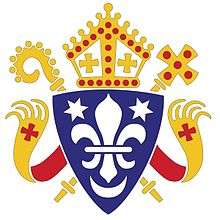St Mary's College, Oscott
| Oscott College | |
|---|---|
| St Mary's College, New Oscott | |
 View of the college from the south | |
 Oscott College Location of college | |
| Coordinates: 52°32′38″N 1°51′20″W / 52.543766°N 1.855451°W | |
| OS grid reference | SP0988894038 |
| Location | New Oscott, Birmingham |
| Country | UK |
| Denomination | Roman Catholic |
| Website |
oscott |
| History | |
| Founded | May 1794[1] |
| Founder(s) | Thomas Walsh |
| Dedication | St Mary |
| Consecrated | 29 May 1838 |
| Associated people |
Cardinal Wiseman |
| Architecture | |
| Status | Theological college |
| Functional status | Active |
| Heritage designation | Grade II* Listed[2] |
| Designated | 25 April 1952 |
| Architect(s) | A.W. Pugin |
| Style | Gothic Revival |
| Groundbreaking | 25 April 1836 |
| Completed | 31 May 1838 |
| Construction cost | £40,000 |
| Administration | |
| Parish | Our Lady of the Assumption Maryvale |
| Deanery | Birmingham (North) |
| Archdiocese | Birmingham |
| Province | Birmingham |
| Clergy | |
| Archbishop | Most Rev. Bernard Longley |
| Rector | Very Rev. Canon Dr David Oakley |
St Mary's College in New Oscott, Birmingham, often called Oscott College, is the Roman Catholic seminary of the Archdiocese of Birmingham in England and one of the three seminaries of the Catholic Church in England and Wales;[3]
Purpose

Oscott College admits students for the priesthood from various dioceses of England and Wales, as well as some students from overseas. The first three years of the academic programme are validated by the University of Birmingham as a BA in Fundamental Catholic Theology. Those who complete the six-year programme also obtain an Bachelor of Sacred Theology (STB) through affiliation with the Katholieke Universiteit Leuven.[4]
Oscott College is also the diocesan centre for the formation of candidates for the permanent diaconate within the Archdiocese of Birmingham.
History
Old Oscott
The college was founded in Oscott, in present-day Great Barr, in 1794 for both the training of priests and the education of lay pupils. It developed out of a small mission founded by Fr Andrew Bromwich around 1687.
New Oscott
In 1838 the college moved to a new site, which came to be known as New Oscott (and the original site as "Old Oscott"). The Maryvale Institute remains on the original site. The new building was designed by Augustus Pugin and Joseph Potter at a cost of £40,000. It is grade II* listed. The college quickly became a symbol of the rebirth of the Catholic faith in England and played a prominent part in the life of the Church in the 19th century. In 1889, the college was closed, but reopened the following year as a seminary only.
21st Century
After the closure of St Cuthbert's College, Ushaw, Durham, in 2011, many of the dioceses in the province of Liverpool sent their students to Oscott to complete their training. This gave a boost in numbers at the college at a time when vocations seemed to be scarce.[5]
Pope Benedict XVI visited on 19 September 2010 following the beatification, earlier that day in Birmingham's Cofton Park, of Cardinal Newman who stayed at the college in the late 1840s. During his visit to Oscott, Benedict met and had lunch with the Roman Catholic bishops of England, Scotland and Wales. The Oscott visit was the last scheduled event during the four-day 2010 State Visit of Benedict to the UK. The Pope would later depart the UK from Birmingham International Airport.
Choral music
A CD of choral music, Sedes Sapientiae, performed by The Schola and recorded live in the college's chapel on 7 June 2008, was released by the college (cat. no. OSCOTTCD01).[6]
Notable alumni
Clergy
Bishops
- Francis Amherst (1819-1883), Bishop of Northampton.
- Edward Bagshawe (1829-1915), Bishop of Nottingham.
- Terence Brain (1938-), Bishop of Salford.
- Kevin Dunn (1950-2008), Bishop of Hexham and Newcastle.
- William Lee (1875-1948), Bishop of Clifton.
- Patrick McCartie (1925-), Bishop of Northampton.
- David McGough, Auxiliary Bishop of the Archdiocese of Birmingham from 2005.
- James McGuinness (1925-2007), Bishop of Nottingham.
- Robert Willson (1794-1866), Bishop of Hobart.
Priests
- William Francis Barry (1849-1930), writer.
- Frederick Charles Husenbeth (1796-1872), writer.
- Henry Weedall (1788-1859), educator.
- William Purcell Witcutt (c.1910-c.1970), author.
Laity
- John Dalberg-Acton, 1st Baron Acton (1834-1902).
- George Ashlin (1837-1921), architect.
- John Ball (1818-1889), Irish politician and naturalist.
- Wilfrid Scawen Blunt (1840-1922), poet.
- Thomas Henry Burke (1829-1882), Permanent Under Secretary at the Irish Office.
- John Cornwell (1940-), writer.
- Charles Kent (1823-1902), journalist and editor.
- Edmund Kirby (1838-1920), architect.
- Ernest Law (1854-1930), historian and barrister.
- Edwin de Lisle MP (1852-1920), politician.
- St. George Jackson Mivart (1827-1900), biologist.
- George Moore (1852-1933), novelist.
- Francis Loraine Petre (1852-1925), civil servant and military historian.
- Thomas Nicholas Redington (1815-1862), Irish political administrator.
- Frederick Rolfe, also known as Baron Corvo (1860-1913), writer and artist.
- Joseph Stevenson (1806-1895), archivist and editor.
- Gerald Strickland, 1st Baron Strickland (1861-1940), Prime Minister of Malta.
Former presidents and rectors
Presidents
|
Rectors
|
Further reading
- The Oscottian - Literary Gazette of St Mary's College, Oscott. Jubilee edition, 1888
- Oscott College in the Twentieth Century, Michael E. Williams, 2001, Gracewing Publishing (ISBN 0-85244-534-2)
References
- ↑ Oscott History
- ↑ British Listed Buildings
- ↑ "Preparing Yourself". Portsmouth Catholic Diocese. Retrieved 31 March 2014.
- ↑ http://www.oscott.net/the-seminary.html
- ↑ UK Vocations Statistics
- ↑ Sedes Sapientiae CD insert
- ↑ List of Superiors, Masters and Students
- ↑ Williams Oscott College p. 183
External links
- St Mary's College website
- Catholic Encyclopedia article
- Historic England. "College (216975)". Images of England.
- Historic England. "Statue of the Virgin Mary (216976)". Images of England.
